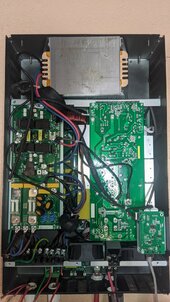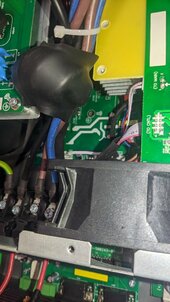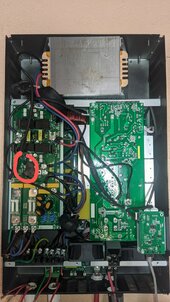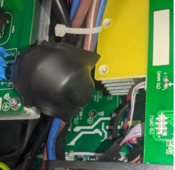Quankl
New Member
- Joined
- Apr 10, 2022
- Messages
- 140
I've been through the wringer with this...
I have my inverter...
I swear everything is correct.
Positive to Positive. Battery cables
Neg to Neg. Battery cables.
Nader DC breaker from Signature recommended for the setup.
Inverter is output to a breaker panel. Separated N and G. Hot1 and Hot2 into a breaker 40A with 10awg as per the manual to feed the breaker.
One circuit in this breaker panel that is going to be running. (Kitchen fridge small. 150w idle. 700w defrost.)
I have AC input from a bonded main panel. Two Hots from each leg, a N and a G.
Setting 34 set to Enable
Iopen close the main Battery DC breaker.
Iopen close the actual breaker on the physical battery to let current flow to the inverter.
I press the power button on the Inverter panel.
Inverter sends 119.8v to the receptacle verified with voltmeter. Which is expected.
I then go to plug in the fridge. Inverter shuts down BP.
I am dumbfounded. I plug in a standing fan like 60watts. It runs for a hour and 20 minutes ish literally sitting in the dark using my phone flashlight. Then BAM. BP error. Battery Disconnected.
What am I doing. Resistance between the battery POS and NEG alternates from Open Loop to no resistance. Will attach video.
No warranty on this as I literally opened it out of curiosity cus I am sure this is willing to try to take my soul out of frustration.
Tried running from either single battery. I have two. No change.
Tried no AC input. No change...
Verified all connections in the inverter fed panel. Correct.
I don't know why these batteries are not feeding my inverter power... Feels like I threw almost 15-20gran away. Btw this is not a signature solar complaint. I just don't know if anyone can see what is going on. I can do a full walk through by video if anyone wants to have a go.
Edit: Will also like to add. The fuse inside the inverter battery terminal is still solid. So it's not that causing the BP as the manual states.
I have my inverter...
I swear everything is correct.
Positive to Positive. Battery cables
Neg to Neg. Battery cables.
Nader DC breaker from Signature recommended for the setup.
Inverter is output to a breaker panel. Separated N and G. Hot1 and Hot2 into a breaker 40A with 10awg as per the manual to feed the breaker.
One circuit in this breaker panel that is going to be running. (Kitchen fridge small. 150w idle. 700w defrost.)
I have AC input from a bonded main panel. Two Hots from each leg, a N and a G.
Setting 34 set to Enable
I
I
I press the power button on the Inverter panel.
Inverter sends 119.8v to the receptacle verified with voltmeter. Which is expected.
I then go to plug in the fridge. Inverter shuts down BP.
I am dumbfounded. I plug in a standing fan like 60watts. It runs for a hour and 20 minutes ish literally sitting in the dark using my phone flashlight. Then BAM. BP error. Battery Disconnected.
What am I doing. Resistance between the battery POS and NEG alternates from Open Loop to no resistance. Will attach video.
No warranty on this as I literally opened it out of curiosity cus I am sure this is willing to try to take my soul out of frustration.
Tried running from either single battery. I have two. No change.
Tried no AC input. No change...
Verified all connections in the inverter fed panel. Correct.
I don't know why these batteries are not feeding my inverter power... Feels like I threw almost 15-20gran away. Btw this is not a signature solar complaint. I just don't know if anyone can see what is going on. I can do a full walk through by video if anyone wants to have a go.
Edit: Will also like to add. The fuse inside the inverter battery terminal is still solid. So it's not that causing the BP as the manual states.
Last edited:










